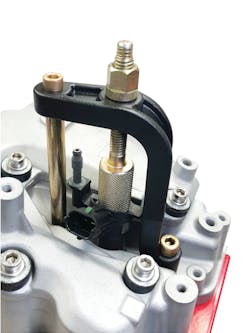Diesel engine service can present unique challenges to technicians. From maintenance items such as removing fuel injectors or cleaning exhaust gas recirculation (EGR) systems, to repairs such as broken bolts in an exhaust manifold, each issue encountered can lead to increased repair time and decreased profit. Fortunately for technicians, there are specialty tools that can help alleviate these challenges. And fortunately for mobile tool distributors, many technicians don’t yet know about these tools. This creates an opportunity to educate customers about these tools and why they could be a sound investment.
Fuel injector removal
Fuel injectors are a relatively common maintenance item when it comes to diesel engines. Over time, they can become clogged or coated with carbon and need to be cleaned. Alternately, fuel injectors can become worn over time due to abrasion caused by fuel impurities, or fail for myriad other reasons. In any case, the resulting work is the same: the fuel injector needs to be removed from the engine.
The problem
This service item can present problems to technicians when injectors are difficult to remove or in a tight spot that is hard to get to. In some cases, the engine may even have to be removed from the vehicle in order to get the fuel injectors out, or the injector may be damaged upon removal. This all leads to the technician not being able to perform his or her job in a timely, efficient manner, resulting in decreased profits.
“If a technician removes a fuel injector improperly, or is unable to remove a fuel injector in the normal timeframe for some unforeseen reason, it can decrease their potential profits and cost them or the shop extra money because of a damaged injector,” says Chad Schley, owner of Schley Products.
The solution
Vehicle OEMs sometimes sell tools that can help alleviate these problems, but often the aftermarket version is more efficient and decreases the risk of damaging the part. For example, SP Tools’ new 16400 Injector Puller Kit removes injectors on 2011-2016 GM pickup trucks equipped with the Duramax LML engine.
“The GM factory tool is known for rocking the injector back and forth, which can bind the injector into the head and potentially cause damage to either the injector or cylinder head,” Schley says. “The 16400 Injector Puller Kit lifts the injector straight up and out, without rocking the part back and forth. This reduces the possibility of damaging any items in the process, and it also helps the technician work more efficiently and do the job quicker.”
Another series of injector pullers is made by Hazet, a manufacturer of hand tools, tool trolleys and equipment. Hazet’s 4798-6/8 can be used for extracting diesel injectors on brands such as Bosch, Delphi, Siemens and Denso, according to Tobias Albertz, marketing and advertising at Hazet.
“[Technicians] can extract injectors without having to remove delicate parts like electrical plug connection or injector head,” Albertz says. “This way, you’re saving the time it would take to dismantle and/or recalibrate the injector.”
EGR system cleaning
EGR systems recirculate diesel exhaust back through the engine to reduce nitrogen oxide emissions. Carbon begins to build up in the system and can eventually clog it, leading to reduced engine performance and fuel economy. When this occurs, the system needs to be cleaned.
The problem
Technicians typically go about this task by dismantling the EGR system and cleaning or replacing individual parts, such as the EGR valve, EGR cooler, turbo or DPF filter. EGR systems are somewhat complicated, however, and dismantling and putting them back together can be an inefficient way to resolve the issue.
The solution
Products such as the MotorVac DieselTune Emissions and Intake Cleaning Tool, from CPS Automotive, are designed to specifically address this condition. This product works by injecting a cleaning solution into the EGR system, eliminating the need for most disassembly.
“The tool creates a foaming action that removes carbon buildup without damaging components,” says Mark Kustra, automotive product marketing manager at CPS Automotive. “This rapidly dissolves the deposits, eliminating the issues commonly associated with plugged EGRs.”
Kustra explains that major diesel fleets are looking for ways to address EGR issues, making these types of stops a good opportunity for mobile tool distributors.
“The trend is to adjust the preventive maintenance schedule to include EGR cleaning,” he says. “These fleet managers are saving the cost of expensive repairs by shifting resources to the maintenance side.”
EGR valve replacement
Even with regular cleaning and maintenance, EGR valves do sometimes need to be replaced. Also, in some states that do not require EGR systems on diesel engines, fleets may choose to have the entire system removed from some vehicles. In both of these situations, technicians need to remove the EGR tube.
The problem
In many cases, the bolts holding the EGR tube to the exhaust manifold will break, significantly increasing repair time.
“That takes roughly a few-minute EGR [valve] repair or replacement and could turn it into a full day job ... 8 hours,” says Jeffrey Del Rossa, president of ProMAXX.
Del Rossa explains that this is because most technicians will then attempt to drill out the broken bolts, a difficult process when dealing with something like a 6mm titanium bolt.
The solution
ProMAXX offers a solution that may be able to reduce the time this repair takes on the 6.7L Ford diesel engine. The kit works by drilling the broken bolt out to 12mm, and adding a stainless steel insert that locks into place.
“The ProMAXX Nino EGR Tube Repair Kit tool drops right into the exhaust manifold on the 6.7L Ford diesel, and allows [technicians] to take the bolts out and redo the bolts,” Del Rossa says. “[They can then] put inserts in there to replace and repair it in under an hour, saving the shop a full 7 hours.”
Del Rossa notes that ProMAXX also makes kits for other Ford, International and GM diesel engines.
Making the case
One of the best ways to sell specialty tools is to educate yourself and know the product. Most companies offer a plethora of information on their websites, with many including pictures and video instructions, which can serve as helpful demonstrations for a tool that would be otherwise challenging to show on the tool truck.
Another good tactic is to explain the return on investment, and how quickly that can be realized in time savings alone. Schley Products’ Chad Schley says that the company’s 16400 can be paid for in just a few uses.
“Specialty tools such as this are an investment, allowing technicians to increase their profit earning potential during a typical work day,” he says. “After using the 16400 injector puller a few times, the tool's return on investment is realized.”
ProMAXX’s Del Rossa also explains how the NINO’s ROI is realized.
“The average diesel bill rate across authorized dealerships is about $120 an hour,” Del Rossa says. “If they can bill five hours and it takes them about an hour to make the repair, they can save four hours ... at $120 an hour, times four, that’s [nearly] $500. They’re going to pay for the tool the very first time they use it.”
Conclusion
Diesel engine service tools can be a relatively easy sell when the right products are offered to the right audience. When selling these types of specialty tools, it's important to seek out fleets, dealerships and independent shops that service diesel engines specifically. Customers here will be more likely to appreciate the value these products can add to their business.
About the Author
David Brierley
Editor | Fleet Maintenance
David Brierley is the editor of Fleet Maintenance magazine.
Brierley’s education and career have been based in the publishing industry. He is an award-winning writer and comes from a background in automotive, trucking, and heavy equipment. Brierley joined the Endeavor Business Media vehicle repair group in 2017 as managing editor for Fleet Maintenance, PTEN, and Professional Distributor magazines, as well as VehicleServicePros.com. In his current role, he writes for and oversees production of Fleet Maintenance magazine. He has worked in the publishing industry since 2011.

